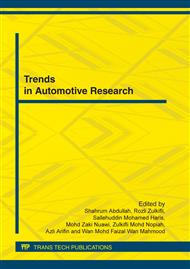p.114
p.120
p.125
p.130
p.135
p.140
p.145
p.150
p.155
Characterisation of the Sound and Vibration Signal of Impact Testing on Automotive Component Materials
Abstract:
Dynamic response of automotive component materials which are carbon steel S50C and cast ironon its sound and vibration characteristichas been studied. This paper shows that I-kaz analysis method can be applied to characterise this dynamic behavior problem. In the present work, an excitation has been performed by an impact hammer at the center of a rectangular bar specimen instrumented with accelerometer and microphone to obtain sound and vibration time-histories. From the experimental results, it was found that the recorded sound and vibration signal has a transient characteristic with high oscillation. Frequency spectrum analysis shows that impact testing on any material will generate its own characteristic of frequency peak and constantboth for sound and vibration signal. From I-kaz analysis method, it can be concluded that I-kaz coefficient, for sound signal is proportional to the modulus of elasticity, density and Poissons ratio. It is also shown that for vibration signal is inversely proportional to these mechanical properties.Data scattering representation supported this pattern of .
Info:
Periodical:
Pages:
135-139
Citation:
Online since:
April 2012
Keywords:
Price:
Сopyright:
© 2012 Trans Tech Publications Ltd. All Rights Reserved
Share:
Citation:


